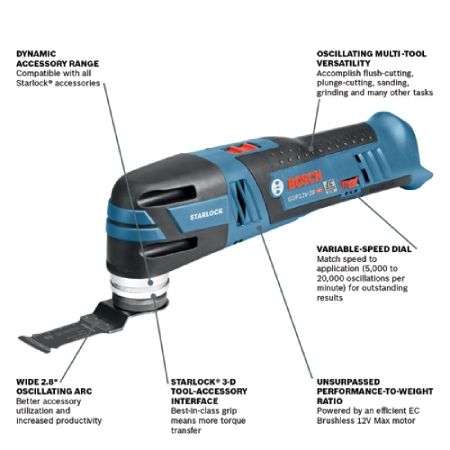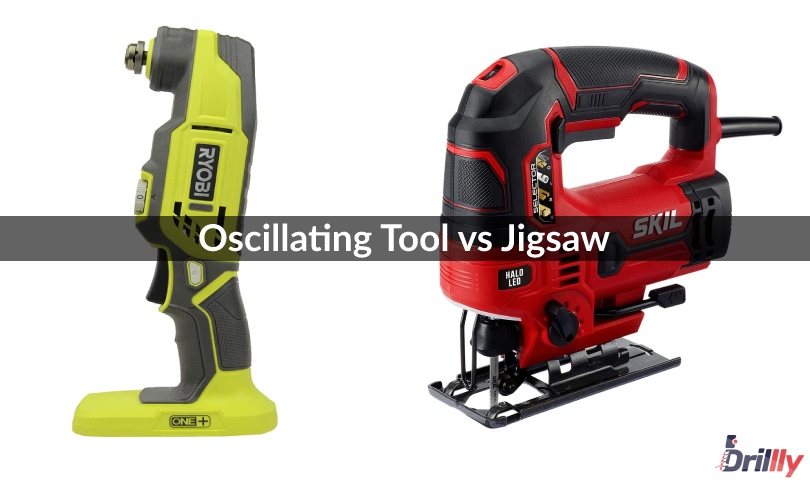Oscillating tools are great for obscure jobs while jigsaws are more mandatory. If you take your projects seriously, you may need both.
Let’s dig deeper and see how they vary and which you will actually need as a home-based DIY enthusiast or a pro.
What are oscillating multi-tools?

Oscillating tools are one of the most adaptable power tools you can get as a DIY enthusiast. They’re L-shaped and have about 15-inch long tubular bodies with a 90° turn on the front end in most cases.
They have this name since they are run by an oscillating motion, which means they shake their head from side to side to function at an extraordinarily high speed; i.e., around 20,000 times per minute.
Powered by both cords and batteries, you can add lots of accessories for a range of jobs, including trimming pipes and floorboards, cutting out drywall openings, removing rust from metals, scraping adhesive substances, plunge cuts in decking, sanding furniture, and many more.
What are jigsaws?

Jigsaws are handheld power saws with reciprocating blades that move back and forth with great intensity and speed to cut through materials. You can cut various shapes and rough curves into different materials, including wood, plywood, plastic, particleboard, ceramic tile, and even metal.
You can actually compare jigsaws with clothes irons. The only difference is that there is a rough tooth blade that pushes up and down at a high speed rather than steam and heat coming out of the base.
Jigsaws can support a variety of blades and are powered by batteries and cords.
Differences Between Oscillating Tools and Jigsaws
Motion
Oscillating tool

Motion is the primary factor that differentiates these tools although they might seem pretty identical. The way the blades and arcs are moved is not the same. The blade of an oscillating multi-tool moves 4.5° side to side very quickly.
Jigsaw

A jigsaw moves with a reciprocating motion to push the blade back and forth or up and down. You need some space on the opposite side of the workpiece so the blade moves in the motion freely.
Speed
Oscillating tool
An oscillating multi-tool has a much slower and limited range of motion with the ability to oscillate up to 20,000 times per minute. The oscillation may feel and look like vibrations while operating with your hands.
Jigsaw
A jigsaw blade moves faster with a wider range of motion than oscillating tools. It can, by and large, reciprocate both slower and faster, starting at 300 and up to 3,500 whacks per minute.
But that does not mean that a jigsaw will be slower at cutting. In fact, a jigsaw will give you more control over the type of cut you want or the amount of stroke you need.
Size and Weight
Oscillating tool
Longer, cylindrical, lighter, and thinner than jigsaws, they weigh around 3lbs. You’ve to hold and operate them just the way you use a Dremel tool.
Oscillating tools themselves can’t reach narrow spaces due to their length without attachments, but they’re still a more versatile choice considering the number of heads and accessories you can use with them.
Jigsaw
Jigsaws are bulkier, heavier, and shorter but both types are light enough to operate with a single hand. Jigsaws can weigh up to 6lbs and more.
Durability and Longevity
Oscillating tool
Oscillating multi-tools are not the sturdiest ones, especially their heads and accessories. On average, they serve well for about 2-3 years.
Jigsaw
These saws do last a long time due to their materials and quality. You can confidently use them for roughly 5-6 years.
Cost
Oscillating tool
An entry-level model of any of these tools will cost you around $100. Expect to spend a lot more when you are after high-end tools.
Jigsaw
Jigsaws tend to be fairly pricier than oscillating tools. A top-notch jigsaw can set you back $200 to $400.
Applications
Oscillating tool
Oscillating tools can be used for many purposes as they’re designed to be exceptionally versatile. You can get a saw blade as an attachment and use it to cut materials just like a saw even though sawing is not what they are best at.
The wonderful thing about an oscillating tool is that it becomes a grinder when you attach a grinding bit. Similarly, a sanding bit makes it a sander, a cutting attachment allows it to be cut, and a polishing add-on allows you to varnish with it.
Jigsaw
Jigsaws have a single purpose, to cut wood (fundamentally) and other materials including plastics, plywoods, metal sheets, and ceramic tiles.
More specifically, jigsaws are used to cut irregular patterns and curves into thin wood planks. You need a more fortified jigsaw and special kinds of blades to cut into the metal, plastic, or ceramic-like materials.
Which of the two should you use?
Now that you know all the differences between the two, it should be much easier to make a better decision. Consider a jigsaw in case you need to make longer cuts or disproportionate curves into wood boards and other materials every now and then.
An oscillating multi-tool is your go-to choice when you have small cutting tasks to do. Also, it can grind, sand, or polish tricky areas where a jigsaw can’t reach easily, such as under a door frame.
FAQs
1. Is an oscillating saw the same as a jigsaw?
Ans: No, they are different power tools for different purposes but belong to the same niche. An oscillating tool is more versatile as it can have several attachments for a number of different tasks, while a jigsaw has the sole purpose of cutting through thin wood and other materials.
2. Can an oscillating tool cut concrete?
Ans: Yes, you can but you’ve to attach a carbide grit oscillating blade with your tool. Oscillating multi-tools may not be ideal for concrete cutting but they can handle grout-removing tasks well.
3. Is an oscillating tool a grinder?
Ans: Yes, you can use it as a grinder with a grinding attachment. Oscillating tools have many accessories for executing several operations, including scraping, polishing, and sanding.
4. How deep can an oscillating tool cut?
Ans: Oscillating tools can cut as deep as the size of their blades, usually between 1 and 3 inches. Pick the right blade for your particular job to cut as per your requirements.
5. What materials can jigsaws cut?
Ans: Jigsaws can cut a number of materials such as wood boards, plastics, plywoods, metal sheets, and even ceramic tiles when you use the right type of blade.








